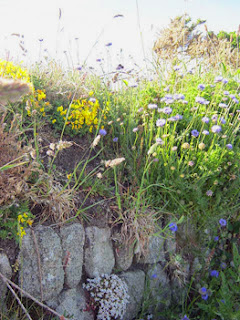Once you leave the bony spine of central Cornwall – Kernow – behind, the lanes are so lush. I thought ours in the South Hams were spectacular, but the profusion of wild flowers is pretty much unequalled: bluebells, buttercups, campions and foxgloves, of course, as it’s early June, but on the stone ‘hedges’ also the pretty deep-blue discs of scabious, yellow orange and red trefoil, starry white sedum, pink thrift and the white bladder campion.
This part of Britain, another ‘edge’ or liminal place, like all the others to which I‘m drawn, has more prehistoric sites per square mile than almost anywhere in northern Europe, and it’s hard for me to know which to leave out for the Poetry, Place & Pilgrimage course. We’ve snatched a day out of a busy time, TM and I, to check out a circular route I plan to take the group on this week.
We begin at the sacred centre, it feels to me, of West Penwith: the holy well at Sancreed. The name itself is christianised, but my perception is that it may well be a corruption of Cerridwen, one of the faces of the ancient British Goddess of the land. Nestling below the ancient Sancreed Beacon, certainly the holy well here has an exceptional quality to it (and apparently the background radiation is about 200% the normal, which gives a kind of almost hypnotic quality to the immediate area). I came here once with my dowsing rods, which spun and twirled crazily on the approach to the well.
The well itself is preceded by a ‘cloutie tree’: a hawthorn hung with offerings, some tacky, some beautiful. If you squat on the second step down, the walls of the well glow with phosphorescence. Nearby are the walls of a tiny chapel.
We head across fields over stiles until we start to climb towards Caer Bran, ‘Bran’s Castle’, an Iron Age fort on a probably older site (like most of the remains here). Partway up we stop in an iconic meadow with a variety of grasses; reclining here beside the ruins of a farmhouse is paradise, and the sea is visible to both sides of the peninsula: Mount’s Bay with St Michael’s Mount where ley-hunters will tell you the major St Michael leyline which tracks across southern England to emerge on the coast in East Anglia enters Britain (friends of mine have tracked this ley through Europe to Delphi), and the other way the white dunes of Hayle and Gwithian appear, beyond which is the lighthouse of Virginia Woolf fame.
The waymarker is this beautiful Brane (‘Bran’) Cross.
You can see how prolific the verges and banks are here on the little path up to the Iron Age fort of, presumably, Bran.
This is a double earthwork with a defensive ditch, though undoubtedly the ‘fort’ was also used for gatherings, ritual and ceremony.
Bran is Bran of the speaking, or singing, head of Celtic mythology. His name means ‘raven’. I’ll tell his story another time, but in brief he was the son of Manannan mac Lir, or Llyr, the sea-god, and as a semi-deity himself was entrusted perhaps with the guardianship of the sovereignty of Lady of the Land. When his head was cut off in battle, he continued to speak and sing (prophesy), and told his followers to keep his head with them until eventually they were to bury it in the White Mount at the Tower of London. As long as his head remained interred, and the ravens remained at the Tower, Britain would not fall (there’s more to say on that, but another time).
From Caer Bran we follow a little track to the wells at Chapel Euny, where they have opened up a further bridleway to continue one of the old tracks.
It’s Open Studios in Cornwall, and close to the Iron Age courtyard settlement of Carn Euny, I call in to Hester Dunnett’s studio, with some exquisitely atmospheric paintings; hard for them not to be, living where she does.
Then we emerge into the sun-glazed courtyard village which, despite it being a sunny weekend and so we are not alone, has a profound feeling of calm and restfulness to it.
Unique, pretty much, to Cornwall are the fogous: Iron Age cave-tunnels, shaped like birth canals, with, usually, a ‘creep chamber’ off to one side. They are frequently if not always aligned to a significant solstice sunrise or sunset, and there is much speculation as to their purpose. I have my own ideas about this (also another time), but suffice it to say they too are probably ceremonial.
And then to the sea at Cape Cornwall, where my course is taking place – and the late afternoon is the kind of blue that stops your voice; the sea barely creased, and the point where horizon meets sky not even an edge, but a seamless whole.














No comments:
Post a Comment